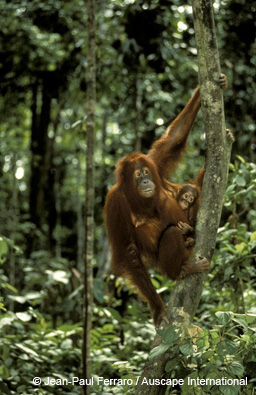Conservationists have found a previously-unknown population of orangutans in Indonesian Borneo, which may number up to 2,000.

A Nature Conservancy survey of remote and largely inaccessible limestone mountains in the East Kalimantan province, carried out last December, found 219 orangutan ‘nests’ (branches and leaves pulled together to form sleeping platforms in the canopy). The team also observed three orangutans in the canopy – a mother and her baby, and a large male who broke off branches to throw at them.
The nests were in a relatively small area, which indicates there could be several thousand orangutans in the region, belonging to the sub-species Pongo pygmaeus morio. This adds a significant number to the Bornean orangutan population, which is estimated at approximately 57,000. Most known populations are small and fragmented from one another, so to discover a large group is a significant boost for the species.
Orangutan populations have crashed during the past 200 years, as a result of deforestation of their habitat. Today the species continues to be threatened by habitat loss, degradation and fragmentation as a result of legal and illegal logging, forest fires, illegal gold mining, and conversion to agriculture, in particular oil palm plantations; more than 80% of orangutan habitat has been altered or destroyed by these factors. The species’ highly arboreal lifestyle makes them particularly vulnerable to habitat fragmentation, as they rarely travel long distances on the ground.
However, this newly discovered group may be protected from factors threatening other populations, because the rocky terrain, steep topography and remote location mean that plantations cannot be developed easily. “From that perspective it’s exciting, because it provides real hope,” said Nature Conservancy scientist Erik Meijaard.
Orangutans normally inhabit swampy forest habitats with diverse fruit trees, so were not expected in this remote and rocky landscape, especially not in such large numbers. However, several varieties of fruit tree were found growing on limestone plateaus. The 2,500 sq km of rainforest escaped the fires started by plantation owners and farmers that devastated the surrounding forests in the late 1990s, so it may be that several populations congregated in this region from areas which did suffer from fires.
The team is now working with local groups and the Indonesian Government to try to protect the region. However, concerted work is required to conserve this remarkable species in areas which are more accessible and therefore still susceptible to deforestation.

